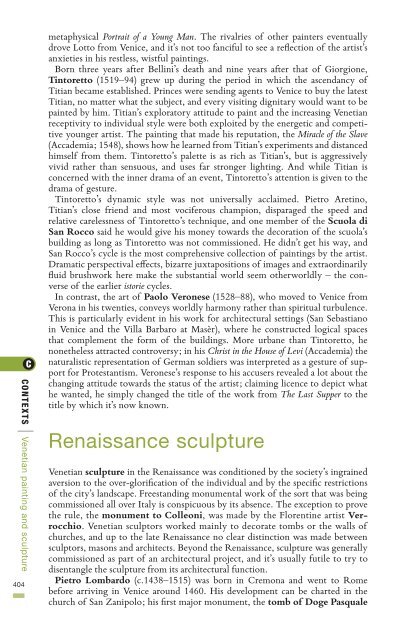Create successful ePaper yourself
Turn your PDF publications into a flip-book with our unique Google optimized e-Paper software.
CONTEXTS<br />
|<br />
Venetian painting <strong>and</strong> sculpture<br />
404<br />
metaphysical Portrait of a Young Man. <strong>The</strong> rivalries of o<strong>the</strong>r painters eventually<br />
drove Lot<strong>to</strong> from <strong>Venice</strong>, <strong>and</strong> it’s not <strong>to</strong>o fanciful <strong>to</strong> see a reflection of <strong>the</strong> artist’s<br />
anxieties in his restless, wistful paintings.<br />
Born three years after Bellini’s death <strong>and</strong> nine years after that of Giorgione,<br />
Tin<strong>to</strong>ret<strong>to</strong> (1519–94) grew up during <strong>the</strong> period in which <strong>the</strong> ascendancy of<br />
Titian became established. Princes were sending agents <strong>to</strong> <strong>Venice</strong> <strong>to</strong> buy <strong>the</strong> latest<br />
Titian, no matter what <strong>the</strong> subject, <strong>and</strong> every visiting dignitary would want <strong>to</strong> be<br />
painted by him. Titian’s explora<strong>to</strong>ry attitude <strong>to</strong> paint <strong>and</strong> <strong>the</strong> increasing Venetian<br />
receptivity <strong>to</strong> individual style were both exploited by <strong>the</strong> energetic <strong>and</strong> competitive<br />
younger artist. <strong>The</strong> painting that made his reputation, <strong>the</strong> Miracle of <strong>the</strong> Slave<br />
(Accademia; 1548), shows how he learned from Titian’s experiments <strong>and</strong> distanced<br />
himself from <strong>the</strong>m. Tin<strong>to</strong>ret<strong>to</strong>’s palette is as rich as Titian’s, but is aggressively<br />
vivid ra<strong>the</strong>r than sensuous, <strong>and</strong> uses far stronger lighting. And while Titian is<br />
concerned with <strong>the</strong> inner drama of an event, Tin<strong>to</strong>ret<strong>to</strong>’s attention is given <strong>to</strong> <strong>the</strong><br />
drama of gesture.<br />
Tin<strong>to</strong>ret<strong>to</strong>’s dynamic style was not universally acclaimed. Pietro Aretino,<br />
Titian’s close friend <strong>and</strong> most vociferous champion, disparaged <strong>the</strong> speed <strong>and</strong><br />
relative carelessness of Tin<strong>to</strong>ret<strong>to</strong>’s technique, <strong>and</strong> one member of <strong>the</strong> Scuola di<br />
San Rocco said he would give his money <strong>to</strong>wards <strong>the</strong> decoration of <strong>the</strong> scuola’s<br />
building as long as Tin<strong>to</strong>ret<strong>to</strong> was not commissioned. He didn’t get his way, <strong>and</strong><br />
San Rocco’s cycle is <strong>the</strong> most comprehensive collection of paintings by <strong>the</strong> artist.<br />
Dramatic perspectival effects, bizarre juxtapositions of images <strong>and</strong> extraordinarily<br />
fluid brushwork here make <strong>the</strong> substantial world seem o<strong>the</strong>rworldly – <strong>the</strong> converse<br />
of <strong>the</strong> earlier is<strong>to</strong>rie cycles.<br />
In contrast, <strong>the</strong> art of Paolo Veronese (1528–88), who moved <strong>to</strong> <strong>Venice</strong> from<br />
Verona in his twenties, conveys worldly harmony ra<strong>the</strong>r than spiritual turbulence.<br />
This is particularly evident in his work for architectural settings (San Sebastiano<br />
in <strong>Venice</strong> <strong>and</strong> <strong>the</strong> Villa Barbaro at Masèr), where he constructed logical spaces<br />
that complement <strong>the</strong> form of <strong>the</strong> buildings. More urbane than Tin<strong>to</strong>ret<strong>to</strong>, he<br />
none<strong>the</strong>less attracted controversy; in his Christ in <strong>the</strong> House of Levi (Accademia) <strong>the</strong><br />
naturalistic representation of German soldiers was interpreted as a gesture of support<br />
for Protestantism. Veronese’s response <strong>to</strong> his accusers revealed a lot about <strong>the</strong><br />
changing attitude <strong>to</strong>wards <strong>the</strong> status of <strong>the</strong> artist; claiming licence <strong>to</strong> depict what<br />
he wanted, he simply changed <strong>the</strong> title of <strong>the</strong> work from <strong>The</strong> Last Supper <strong>to</strong> <strong>the</strong><br />
title by which it’s now known.<br />
Renaissance sculpture<br />
Venetian sculpture in <strong>the</strong> Renaissance was conditioned by <strong>the</strong> society’s ingrained<br />
aversion <strong>to</strong> <strong>the</strong> over-glorification of <strong>the</strong> individual <strong>and</strong> by <strong>the</strong> specific restrictions<br />
of <strong>the</strong> city’s l<strong>and</strong>scape. Freest<strong>and</strong>ing monumental work of <strong>the</strong> sort that was being<br />
commissioned all over Italy is conspicuous by its absence. <strong>The</strong> exception <strong>to</strong> prove<br />
<strong>the</strong> rule, <strong>the</strong> monument <strong>to</strong> Colleoni, was made by <strong>the</strong> Florentine artist Verrocchio.<br />
Venetian sculp<strong>to</strong>rs worked mainly <strong>to</strong> decorate <strong>to</strong>mbs or <strong>the</strong> walls of<br />
churches, <strong>and</strong> up <strong>to</strong> <strong>the</strong> late Renaissance no clear distinction was made between<br />
sculp<strong>to</strong>rs, masons <strong>and</strong> architects. Beyond <strong>the</strong> Renaissance, sculpture was generally<br />
commissioned as part of an architectural project, <strong>and</strong> it’s usually futile <strong>to</strong> try <strong>to</strong><br />
disentangle <strong>the</strong> sculpture from its architectural function.<br />
Pietro Lombardo (c.1438–1515) was born in Cremona <strong>and</strong> went <strong>to</strong> Rome<br />
before arriving in <strong>Venice</strong> around 1460. His development can be charted in <strong>the</strong><br />
church of San Zanipolo; his first major monument, <strong>the</strong> <strong>to</strong>mb of Doge Pasquale







